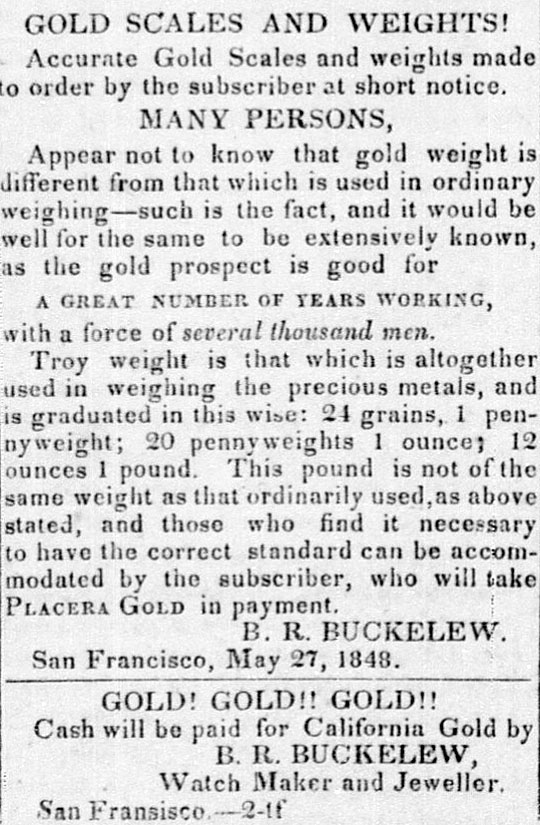Very Important Passengers

B. R. Buckelew
The Californian was California's first newspaper, printed first in 1846, half in English and half in Spanish, established in Monterey by Colton and Robert Semple in 1846. In July of 1847, B. R. Buckelew succeeded Semple as proprietor and editor, eliminated "The" and changed the name to "Californian."
Buckelew published the first story of gold nearly two months after its initial discovery.
March 15, 1848, Californian, Monterey
In the newly made raceway of the Saw Mill recently erected by Captain Sutter, on the America Fork, gold had been found in considerable quantities. One person brought thirty dollars worth to New Helvetia, gathered there in a short time. California, no doubt is rich in mineral wealth, great chances here for scientific capitalists. Gold has been found in almost every part of the country.
Eastern newspapers depended on the reports by the Californian and its rival, the California Star(started by Sam Brannan in 1848 and edited by New Yorker Edward Kemble), for their first reports of gold in California. San Francisco had fewer than 400 residents at the time.
As many other California businessmen did with their companies, Buckelew closed his newspaper in the summer of 1848, giving it to the editor of the California Star, which had folded earlier when its workers joined the rush to the gold fields.
April 26, 1848, Californian, Monterey
B. R. Buckelew, respectfully informs the citizens of California, that he has located permanently in the Town of San Francisco, for the purpose of pursuing his profession.
WATCHES, CLOCKS, JEWELRY, and other fine Metalic work repaired in the BEST MANNER, and on terms proportional with general prices in California. Business entrusted through a friend, will be attended to the same as with the person proper. WATCH GLASSES and KEYS fitted. CASH INVARIABLY REQUIRED except otherwise previously understood.
May 24, 1848, Californian, Monterey

If you cannot find recommended books locally, consider the links provided to
Amazon.com which has proven to be reliable on service and delivery.
Immigration at the Golden Gate: Passenger Ships, Exclusion, and Angel Island
Robert Eric Barde
Perhaps 200,000 immigrants passed through the Angel Island Immigration Station during its lifetime, a tiny number compared to the 17 million who entered through New York's Ellis Island.
Nonetheless, Angel Island's place in the consciousness of Americans on the West Coast is large and out of proportion to the numerical record. Angel Island's Immigration Station was not, as some have called it, the Ellis Island of the West, built to facilitate the processing and entry of those welcomed as new Americans. Its role was less benign: to facilitate the exclusion of Asians, starting with the Chinese, then Japanese, Koreans, Indians, and all other Asians.
Family Skeletons: Exploring the Lives of Our Disreputable Ancestors
Simon Fowler, Ruth Paley
Most families have a skeleton. You may have already discovered yours via the grapevine or your own research. Or you may simply be intrigued by the dark side of our past. This popular history explores the behaviour of our disreputable ancestors from the unfortunate to the criminal, and introduces a host of colourful characters including 17th century witches, 18th century 'mollies' and Victorian baby farmers. Thematically arranged by skeleton, the text also describes how society punished and provided for its 'offenders' - as well as the changing attitudes that could ultimately bring acceptance.

(Themes in World History)
Patrick Manning
Drawing on examples from a wide range of geographical regions and thematic areas, noted world historian Patrick Manning guides the reader through trade patterns, including the early Silk Road and maritime trade, effect of migration on empire and industry, earliest human migrations, major language groups, various leading theories around migration.

The Naval Order of the United States has a history dating from 1890. Membership includes a wide range of individuals, many with highly distinguished career paths. When it was established, the Founders provided "that any male person above the age of eighteen years who either served himself, was still presently serving, or was descended from an officer or enlisted man who served in any of the wars which the U.S. Navy, Marine Corps, or Revenue or Privateer services was engaged was eligible for Regular membership." Today, the Order is a "by invitation only" society, and includes men and women who have served or who assist in accomplishing its Mission, including research and writing on naval and maritime subjects.
The San Francisco Commandery meets the first Monday of each month in San Francisco, California and holds two formal dinners each year:


 Copyright ~ 1998-2018.
Copyright ~ 1998-2018. 